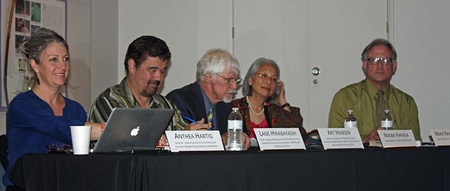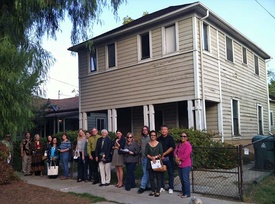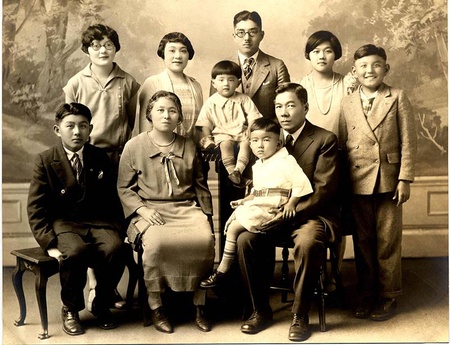(Presentation at the Riverside Metropolitan Museum, in Riverside, California, on October 20, 2012, for a program to celebrate publication of Mark Howland Rawitsch’s 2012 book, The House on Lemon Street: Japanese Pioneers and the American Dream, published by the University Press of Colorado in the Lane Hirabayashi-edited NIKKEI IN THE AMERICAS series)

Speakers (L-R: Anthea Harting, Lane Hirabayashi, Art Hansen, Naomi Harada, Mark Howland Rawitsch). Courtesy of the Riverside Metropolitan Museum; Photographer Katherine Dopler Wilson
Much like houses and homes, intellectual projects and professional careers are works in progress, social constructions enacted over time and contingent upon such circumstantial factors as people and places and the complex interactions between them and forces within the wider world.

Group outside the Harada House. Courtesy of the Riverside Metropolitan Museum. Photographer Dr. Catherine Gudis
We are very fortunate indeed to be brought together here today at the Riverside Metropolitan Museum to commemorate the publication of a landmark book in the combined fields of Asian American Studies and Public History, Mark Howland Rawitsch’s The House on Lemon Street: Japanese Pioneers and the American Dream. In that volume, the first to be published in Lane Hirabayashi’s exciting new Nikkei in the Americas series for the University Press of Colorado, Mark contributes a marvelous epilogue in which he charts for readers the origins and development of not only his seminal work, but also the institutionalization of the National Historic Landmark Harada House (which, of course, this present event honors along with The House on Lemon Street book).
The palpable core of Mark’s epilogue is his absorbing depiction of the deepening personal relationship and correlated open-ended and far-ranging conversation that he enjoyed with Sumi Harada over three decades. This is altogether appropriate, since Sumi was the last, the longest, and the most posterity-conscious Harada family occupant of the Lemon Street house in Riverside that, to quote Mark, “is now recognized and celebrated in California and nationally for its historical significance because of its association with the first Japanese American court test of the California Alien Land Law of 1913 and for its later link to the experiences of forced [wartime] removal and [postwar] return of [West Coast Americans of Japanese ancestry]."

Harada Family Portrait, 1928. Rear, left to right, Mine, Mary (Mrs. Masa Atsu Harada), Masa Atsu and son, Calvin, Sumi, and Clark; front, left to right, Yoshizo, Ken, Harold and Jukichi. Courtesy of the Riverside Metropolitan Museum, Harada Family Collections.
After a great deal of agonizing internal debate, I have decided to approach my presentation this afternoon in the spirit of Mark’s epilogue.
Please permit me to explain. It had been my original intention to situate the spirited act of resistance enshrined by Jukichi Harada’s successful 1918 judicial testing of the oppressive California Alien Land Law of 1913 within the full chronological sweep of the Japanese American experience. I wanted through such an approach to challenge the widespread notion held outside and even inside the Japanese American community that a cultural predisposition toward acceptance of unalterable circumstances, epitomized by the Japanese word shikataganai, had historically precluded Nikkei from resisting racist oppression, even their unconstitutional mass exclusion and confinement by the U.S. government during World War II.
The scenario I envisioned for this talk, then, was to begin in 1868 with the resistance lodged against their employers for breach of contract by the party of 153 sugar plantation laborers, the so-called gannen-mono, who comprised the first mass emigration (from Yokohama to Hawai‘i) of Japanese overseas.
Thereafter, having detailed other notable acts of resistance enacted by Nikkei before, during, and after World War II, I planned to culminate my remarks by making reference to two current-day anti-racist resistance campaigns stirring within the Japanese American community: one, the drive to encourage the public, academia, and governmental agencies to begin using accurate terminology instead of euphemisms when referring to the Japanese American World War II eviction and incarceration experience; and two, the push for mainstream Americans and, most especially, the Nikkei community at large, to revisit and revise the stereotypical notion within the standard narrative of the World War II Japanese American experience that the thousands of Americans of Japanese ancestry who renounced their U.S. citizenship at the Tule Lake Segregation Center did so because they were pro-Japan fanatics disloyal to and contemptuous of their country of birth.
I abandoned this plan of action for three main reasons. First, following it would require much more time than I have at my disposal; second, as I learned after forty years of classroom teaching, afternoon audiences generally respond better to personalized stories than they do to lengthy disquisitions about historical developments, social movements, and cultural phenomena. The third and probably the most paramount reason for my decision to deviate from my initial game plan is my preference for placing a premium on the research method of oral history in my search for historical truth and meaning.
Recently, when reviewing an unpublished manuscript entitled “Off the Record” for publication by a prestigious publishing house’s oral history series, I ran across a luminous statement in the coeditors’ introduction that reminded me anew of the power, possibilities, and moral promise of oral history. I would like you to hear and really listen closely to this statement penned by Anna Sheftel and Stacey Zembrzycki.
Oral history should not simply be about studying people—turning the recorder on and off—and then taking their stories and mining them for facts that support our arguments. It is about valuing people. Although seeing it this way makes the whole idea of oral history exponentially more difficult and emotionally demanding, this is the only way we can try to understand people’s lives. They are special and we thereby need to approach them as such. Thinking this way means that we have to spend more time acknowledging what happens “off the record” in our [oral history] projects. These experiences demand serious consideration.
With this quotation as my launching pad, let me now, in the interest of gaining some insight into what I consider to be a robust Nikkei tradition of protest and resistance, share with you my on- and off-the-record encounters with but one very special Japanese Americans resister I was privileged to know and to interview on tape for the edification of posterity: Sue Kunitomi Embrey (1922-2006), the long-time chair of the Manzanar Committee and its annually sponsored Manzanar Pilgrimage and the individual I consider most responsible for the creation of the National Park Service-administered Manzanar National Historical Site. Sue Embrey was also, to agree with a quoted comment attributed to Lane Hirabayashi, “a legendary leader of the Japanese American Redress movement.”
* * *
Over the thirty-three years of our association, encompassing the period from 1973 to 2006, Sue and I became fast friends and valued colleagues.
Toward the beginning of our relationship, she attended my wedding reception; as our friendship wound down to its inevitable end, I was present at the Buddhist memorial services for her ex-husband Garland and her oldest son Gary, and finally at Sue’s memorial rites.
In the long interval between these vital events, Sue and I were coeditors for two books, one an annotated bibliography of source material on the Manzanar National Historic Site done for the National Park Service, the other an oral history of Harry Ueno, the central figure in the Manzanar Riot of December 6, 1942, published under the title of Manzanar Martyr.
In addition we collaborated, along with others, to author the wording that appears at the site of the onetime Tule Lake Relocation/Segregation Center in northern California and also to prepare a critique of the television movie Farewell to Manzanar.
Finally, Sue accompanied many of my World War II Japanese American Experience classes at Cal State Fullerton for fieldwork forays into Inyo County, where she lodged with my students and me at a Lone Pine motel consisting of onetime barracks at the Manzanar site, led us on orientation tours of the Manzanar site, and participated in educational programs staged at the Eastern California Museum in Independence.
© 2012 Arthur A. Hansen






